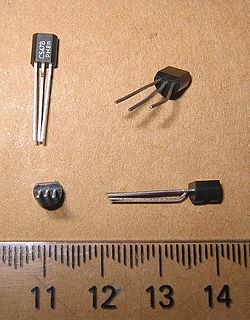
TO92
Encyclopedia

Transistor
A transistor is a semiconductor device used to amplify and switch electronic signals and power. It is composed of a semiconductor material with at least three terminals for connection to an external circuit. A voltage or current applied to one pair of the transistor's terminals changes the current...
enclosure construction. The case is often made of epoxy
Epoxy
Epoxy, also known as polyepoxide, is a thermosetting polymer formed from reaction of an epoxide "resin" with polyamine "hardener". Epoxy has a wide range of applications, including fiber-reinforced plastic materials and general purpose adhesives....
or plastic
Plastic
A plastic material is any of a wide range of synthetic or semi-synthetic organic solids used in the manufacture of industrial products. Plastics are typically polymers of high molecular mass, and may contain other substances to improve performance and/or reduce production costs...
, and offers compact size at a very low cost.
History and origin
The JEDECJEDEC
The JEDEC Solid State Technology Association, formerly known as the Joint Electron Devices Engineering Council , is an independent semiconductor engineering trade organization and standardization body...
TO-92 descriptor is derived from the original full name for the package: Transistor Outline Package, Case Style 92.
Construction and orientation
The case is molded around the transistor elements in two parts; the face is flat, bearing a machine-printed part number.The back is semi-circularly-shaped. By looking closely from the top, one can observe the seam where the two halves are molded together.
The leads protrude from the bottom of the case. When looking at the face of the transistor, the leads are commonly configured from left-to-right as the emitter, base, and collector for 2N series (JEDEC) transistors, however, other configurations are possible, such as emitter, collector, and base commonly used for 2S series (Japanese) transistors.
The leads coming out of the case are spaced 0.05" (1.27 mm) apart. It is often convenient to bend them outward to a 0.10" (2.54 mm) spacing to make more room for wiring. Units with their leads pre-bent may be ordered to fit specific board layouts, depending on the application. Otherwise, the leads may be bent manually; however, care must be taken as they can break easily.
Advantages
- Transistors of this type can be made very inexpensively and take up very little board space. Most models are readily available in large quantities from wholesale distributors.
- They are easy to find in small electronics stores because of their wide usefulness, making them a popular choice for hobby work and prototyping.
Disadvantages
The main disadvantage of this style of case is the lack of heat sinking.- Transistors and ICs of these types cannot handle as much power as higher-power equivalents, such as the TO-220.
- This type of transistor or IC is easily susceptible to heat damage, and can burn out quickly if they dissipate excessive power.
More often than not, however, the disadvantages concerning accidental destruction are greatly outweighed by the small size and low cost of producing these units.
Common transistors that use this case
- BC548BC548The BC548 is a general purpose silicon NPN BJT transistor found commonly in European electronic equipment; the part number is assigned by Pro Electron, which allows many manufacturers to offer electrically and physically interchangeable parts under one identification...
, NPN - BC558, PNP
- 2N39042N3904The 2N3904 is a common NPN bipolar junction transistor used for general purpose low-power amplifying or switching applications. The type was registered by Motorola Semiconductor in the mid-sixties, together with the complementary PNP type 2N3906, and represented a significant performance/cost...
, General purpose NPN - 2N3905, PNP
- 2N39062N3906The 2N3906 is a common PNP bipolar junction transistor used for general purpose low-power amplifying or switching applications. Compared to the general run of silicon transistors, it is designed for low current and power and medium voltage, and can operate at moderately high speeds...
, General purpose PNP-e Effect transistor|FET]]- Leads are 1 SOURCE, 2 GATE, 3 DRAIN
- BS170, N-Channel FET, similar to SN7000
- Leads are 1 DRAIN, 2 GATE, 3 SOURCE
- PN2222A, 2N22222N2222The 2N2222 is a common NPN bipolar junction transistor used for general purpose low-power amplifying or switching applications. It is designed for low to medium current, low power, medium voltage, and can operate at moderately high speeds. It is made in the TO-18 metal can as shown in the picture...
NPN- Leads are 1 EMITTER, 2 BASE, 3 COLLECTOR
- 2SC945, NPN
- Leads are 1 EMITTER, 2 COLLECTOR, 3 BASE
Additional uses of the TO-92 case
- MK484MK484The MK484 AM Radio IC is a fully functional AM radio detector on a chip. It is constructed in a TO-92 case, resembling a small signal transistor. It replaces the similar ZN414 AM radio IC from the 1970s. The MK484 is favored by many hobbyists...
, AM radio ICIntegrated circuitAn integrated circuit or monolithic integrated circuit is an electronic circuit manufactured by the patterned diffusion of trace elements into the surface of a thin substrate of semiconductor material... - 78L05, 79L05, 78L12, 79L1278xxThe 78xx is a family of self-contained fixed linear voltage regulator integrated circuits. The 78xx family is commonly used in electronic circuits requiring a regulated power supply due to their ease-of-use and low cost...
voltage regulators - TCR1AM, Triac
- DS18S20, Temperature sensor
- DS2501-UNW/DS2502, Add-only memory

